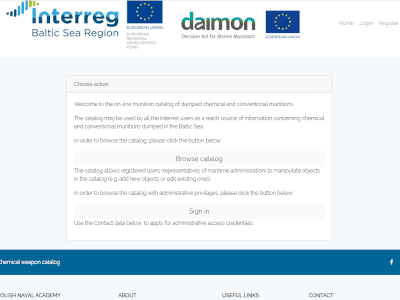DAIMON
Legacy at the bottom of the Baltic Sea
Some 50,000 tons of chemical munitions and 200,000 tons of conventional munitions were dumped into the Baltic Sea after World Wars I and II. So far, there have been no efforts to remove the dangerous legacy from the bottom of the Baltic Sea. However, the recently increasing construction of pipelines, cables and wind farms at sea as well as natural corrosion of dumped containers increase the risk of explosions near populated areas and of contamination of the environment.
Over the years, there was an ongoing discussion on how to assess and manage the environmental risk of dumped ammunition. Although the environmental effects of some of harmful substances, such as arsenic compounds, are well known, in other cases, the knowledge is insufficient to make proper risk assessments.
Budgets
in numbers
-
4.73MillionTotal
-
3.53MillionErdf
-
0.00MillionEni + Russia
-
0.15MillionNorway
Achievements
Impact assessment
DAIMON assessed the environmental impact and biological effects of chemical and conventional munitions dumped at the bottom of the Baltic Sea and Skagerrak that originate from the first and second World Wars, and brought in some practical tools how to manage them safely.
Research project partners performed several sea missions to analyse selected warfare objects, for example the chemical munition in Bornholm and Gdańsk Deep, conventional munition in German coastal waters and the Gulf of Finland, a wreck with chemical munition in the Skagerrak and Måseskär. They analysed samples of sea water, sediments and marine biota on concentrations of hazardous substances around selected munitions. The research proved that dumped munitions could be toxic to the environment due to the degradation and leakage from munition shells.
From knowledge to action
A guidance on how to assess ecological risks for marine organisms caused by dumped munitions and their toxic contents, chemical warfare agents or explosives, complemented by six management strategies served as a basis for developing the decision support system for risk categorisation and decision aid. This online tool supports environmental agencies, maritime administrations, the military, spatial planning and coastguards in handling dumped munitions. Using specific parameters entered into it, the software analyses and categorises risks, and suggests procedures to take, e.g. monitoring, accumulation, recovery or destruction. The online tool developed jointly by the project is available to any authority across the Baltic Sea region. To facilitate its use, in the project follow-up called DAIMON 2, the partners will train respective authorities dealing with the management of marine space (maritime, environmental, fishery, military) and offshore economy stakeholders in integrating the tool into their regular work.
Outputs
Decision Support System for marine munitions

Catalogue of Baltic Sea dumped munitions' types

Toolbox for the Assessment of Marine Munitions impact on biota / EcoTox Toolbox

Project Stories
-
20.12.2016
Disarming the baltic seabed
Decision aid for marine munitions (DAIMON) is a project that was approved under the first call for the Interreg Baltic Sea Region Programme (2014-2020). It aims at supporting maritime, defence and environmental administrations in making decisions on management strategies for dumped chemical and conventional warfare in the Baltic Sea and the Skagerrak.Read full story
Partners
Institute of Oceanology Polish Academy of Sciences (IOPAN)
- TownSopot
- RegionTrójmiejski
- CountryPoland
- RepresentativeJacek Bełdowski
- Phone
- E-Mail
- Web
Polish Naval Academy (PNA)
- TownGdynia
- RegionTrójmiejski
- CountryPoland
- RepresentativeJacek Fabisiak
- Phone
- E-Mail
- Web
Military University of Technology (MUT)
- TownWarszawa
- RegionMiasto Warszawa
- CountryPoland
- RepresentativeStanisław Popiel
- Phone
- E-Mail
- Web
Maritime Institute Gdańsk (MIG)
- TownGdańsk
- RegionTrójmiejski
- CountryPoland
- RepresentativeJoanna Przedrzymirska
- Phone
- E-Mail
- Web
Lithuanian Environmental Protection Agency (LEPA)
- TownVilnius
- RegionVilniaus apskritis
- CountryLithuania
- RepresentativeAlgirdas Stankevičius
- Phone
- E-Mail
- Web
Alfred Wegener Institute Helmhotz Centre for Polar and Marine Research (AWI)
- TownBremerhaven
- RegionBremerhaven, Kreisfreie Stadt
- CountryGermany
- RepresentativeNancy Lange
- Phone
- E-Mail
- Web
Johann Heinrich von Thünen-Institut, Federal Research Institut für Rural Areas, Forestry and Fisheries (TI-FI)
- TownBraunschweig
- RegionBraunschweig, Kreisfreie Stadt
- CountryGermany
- RepresentativeThomas Lang
- Phone
- E-Mail
- Web
Clausthal University of Technology (TUC)
- TownClausthal-Zellerfeld
- RegionGoslar
- CountryGermany
- RepresentativeMatthias Reuter
- Phone
- E-Mail
- Web
University of Helsinki - VERIFIN
- TownHelsinki
- RegionHelsinki-Uusimaa
- CountryFinland
- RepresentativePaula Vanninen
- Phone
- E-Mail
- Web
Finnish Environment Institute (SYKE)
- TownHelsinki
- RegionHelsinki-Uusimaa
- CountryFinland
- RepresentativeKari Lehtonen
- Phone
- E-Mail
- Web
Chalmers University of Technology
- TownGothenburg
- RegionVästra Götalands län
- CountrySweden
- RepresentativeIda-Maja Hasellöv
- Phone
- E-Mail
- Web
Norwegian Defence Research Establishment (FFI)
- TownKjeller
- RegionAkershus
- CountryNorway
- RepresentativeStig-Rune Sellevåg
- Phone
- E-Mail
- Web
-
Project managerJacek BeldowskiInstitute of Oceanology PAS
-
Legal representativeJan Marcin WęsławskiInstitute of Oceanology Polish Academy of Sciences (IOPAN)
-
Financial managerRadosław MałolepszyInstytut Oceanologii Polskiej Akademii Nauk
-
Communication managerKatarzyna FidlerBiuro Projektów Fidler



